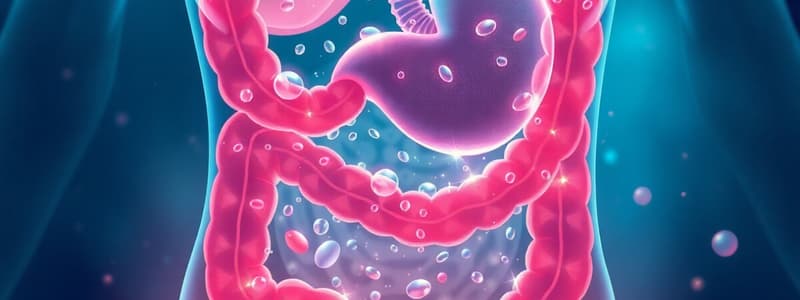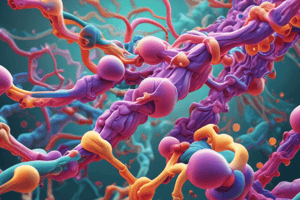Podcast
Questions and Answers
A patient with diabetic gastroparesis is prescribed metoclopramide. What is the primary mechanism by which metoclopramide improves gastric emptying?
A patient with diabetic gastroparesis is prescribed metoclopramide. What is the primary mechanism by which metoclopramide improves gastric emptying?
- Blocking dopamine D2 receptors and enhancing acetylcholine release. (correct)
- Directly stimulating the smooth muscles of the stomach.
- Decreasing the rate of gastric acid secretion.
- Stimulating beta-2 adrenergic receptors in the stomach.
- Inhibiting the production of prostaglandins in the gastric mucosa.
Domperidone is used to treat nausea and vomiting but is associated with a lower risk of extrapyramidal side effects compared to metoclopramide. Why does domperidone have fewer central nervous system side effects?
Domperidone is used to treat nausea and vomiting but is associated with a lower risk of extrapyramidal side effects compared to metoclopramide. Why does domperidone have fewer central nervous system side effects?
- Domperidone is a selective agonist at dopamine D1 receptors.
- Domperidone is a more potent inhibitor of serotonin receptors.
- Domperidone has significantly lower penetration across the blood-brain barrier. (correct)
- Domperidone is primarily metabolized in the peripheral tissues.
- Domperidone stimulates the release of GABA in the central nervous system.
A patient undergoing cancer chemotherapy is prescribed ondansetron to manage nausea and vomiting. What is the primary mechanism of action of ondansetron?
A patient undergoing cancer chemotherapy is prescribed ondansetron to manage nausea and vomiting. What is the primary mechanism of action of ondansetron?
- Inhibiting substance P/neurokinin 1 (NK1) receptors in the brainstem.
- Activating cannabinoid receptors in the vomiting center.
- Antagonizing 5-HT3 receptors in the gastrointestinal tract and CTZ. (correct)
- Blocking dopamine D2 receptors in the chemoreceptor trigger zone (CTZ).
- Stimulating muscarinic receptors to reduce gastric motility.
Scopolamine is used to prevent motion sickness. How does scopolamine exert its anti-emetic effect?
Scopolamine is used to prevent motion sickness. How does scopolamine exert its anti-emetic effect?
Dicyclomine is prescribed for a patient experiencing symptoms of irritable bowel syndrome (IBS). What is the primary mechanism of action of dicyclomine?
Dicyclomine is prescribed for a patient experiencing symptoms of irritable bowel syndrome (IBS). What is the primary mechanism of action of dicyclomine?
Flashcards
What are prokinetic drugs?
What are prokinetic drugs?
Drugs that enhance gastrointestinal motility by increasing the frequency or strength of contractions, facilitating the movement of contents through the digestive tract.
Domperidone's mechanism of action?
Domperidone's mechanism of action?
Domperidone acts primarily as a dopamine D2 receptor antagonist in the chemoreceptor trigger zone (CTZ), reducing nausea and vomiting.
How Metoclopramide works?
How Metoclopramide works?
Metoclopramide enhances gastric emptying and reduces nausea and vomiting by blocking dopamine D2 and serotonin 5-HT3 receptors in the CTZ and peripherally.
Hyoscine butylbromide mechanism?
Hyoscine butylbromide mechanism?
Signup and view all the flashcards
Ondansetron's antiemetic action?
Ondansetron's antiemetic action?
Signup and view all the flashcards
Study Notes
- Prokinetic drugs, anti-emetic drugs, and antispasmodic drugs manage bowel disorders.
Prokinetic Drugs
- Prokinetic drugs are classified to enhance gastrointestinal motility.
- The pharmacokinetics of prokinetic drugs involves absorption, distribution, metabolism, and excretion, varying across different drugs.
- Prokinetic drug mechanisms of action differ based on class.
- Some enhance acetylcholine release.
- Others antagonize dopamine receptors.
- Some directly stimulate motility.
- Prokinetic drugs treat gastroparesis, gastroesophageal reflux disease (GERD), and constipation.
- Adverse effects include nausea, abdominal cramping, and potential cardiac issues.
Anti-Emetic Drugs
- Anti-emetic drugs are classified to prevent and treat nausea and vomiting.
- Anti-emetic drug mechanisms of action differ based on class.
- Some block serotonin receptors.
- Others block dopamine receptors.
- Some block histamine receptors.
- Some block neurokinin receptors.
- Anti-emetic drugs treat chemotherapy-induced nausea, postoperative nausea, and motion sickness.
- Adverse effects include drowsiness, dry mouth, and constipation.
Antispasmodic Drugs
- Antispasmodic drugs include anticholinergics and direct smooth muscle relaxants.
- Antispasmodic drug mechanisms of action differ based on class.
- Some block acetylcholine receptors, reducing smooth muscle contractions.
- Others directly relax smooth muscle.
- Therapeutic uses include treating irritable bowel syndrome (IBS) and reducing bladder spasms.
- Adverse effects include dry mouth, blurred vision, and urinary retention (especially with anticholinergics).
Studying That Suits You
Use AI to generate personalized quizzes and flashcards to suit your learning preferences.
Description
This lesson covers prokinetic, anti-emetic, and antispasmodic drugs used to manage bowel disorders. It discusses the classification, pharmacokinetics, and mechanisms of action of each drug type. It also includes their use in treating conditions like gastroparesis and GERD.




